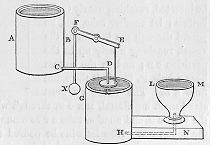If it is desired to adapt this contrivance for use, so that from a goblet occupying any given position a considerable quantity of water may be drawn and yet the goblet remain full, proceed as follows. Let A B
 (fig. 20) be a vessel containing as much water as will probably be
required, and C D a pipe leading from this into a trough beneath, G H.
Near the pipe fix a lever beam, E F, and at the extremity E A suspend
a piece of cork, K, so that it may float in the trough; at the other
extremity F let a chain be fastened furnished with a leaden weight, X.
Let the whole be so arranged that the cork, floating on the water in G
H, closes the mouth of the pipe; yet that, when water has been drawn
from the trough, the cork, being heavier than the weight at X, shall
sink and open the pipe, so that the water may flow in again and raise
the cork. Let L M be the goblet placed in any convenient position, its
lip being on a level with the surface of the water in the trough when
there is no discharge from the pipe owing to the floating cork: and let
the tube H N lead from the trough into the bottom of the goblet. Now
if, when the goblet is full, we draw water from it, we shall at the same
time reduce the water in the trough; and the cork sinking will unclose
the pipe, so that the water, flowing both into the trough and the
goblet, will again raise the cork, and the discharge will cease. And
this will happen as often as we remove water from the goblet.
(fig. 20) be a vessel containing as much water as will probably be
required, and C D a pipe leading from this into a trough beneath, G H.
Near the pipe fix a lever beam, E F, and at the extremity E A suspend
a piece of cork, K, so that it may float in the trough; at the other
extremity F let a chain be fastened furnished with a leaden weight, X.
Let the whole be so arranged that the cork, floating on the water in G
H, closes the mouth of the pipe; yet that, when water has been drawn
from the trough, the cork, being heavier than the weight at X, shall
sink and open the pipe, so that the water may flow in again and raise
the cork. Let L M be the goblet placed in any convenient position, its
lip being on a level with the surface of the water in the trough when
there is no discharge from the pipe owing to the floating cork: and let
the tube H N lead from the trough into the bottom of the goblet. Now
if, when the goblet is full, we draw water from it, we shall at the same
time reduce the water in the trough; and the cork sinking will unclose
the pipe, so that the water, flowing both into the trough and the
goblet, will again raise the cork, and the discharge will cease. And
this will happen as often as we remove water from the goblet.